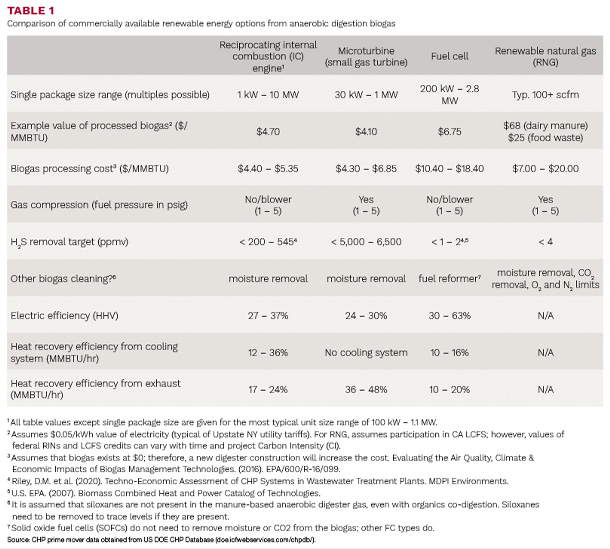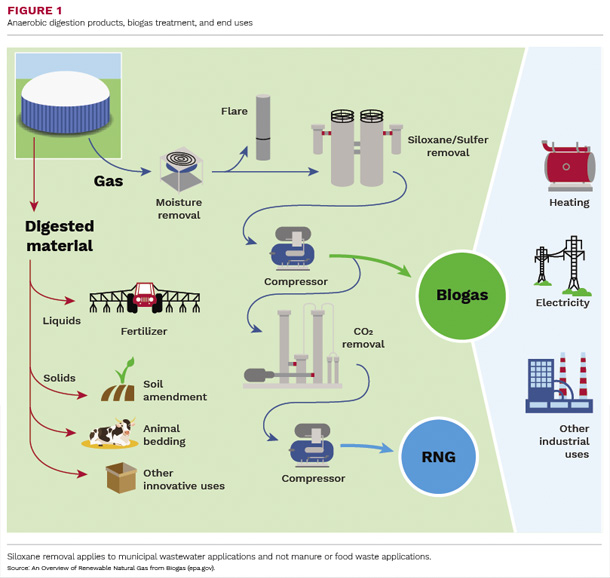Other systems have been proposed to work with anaerobic digestion or on their own; these include hydrothermal liquefaction (HTL) to produce biocrude oil, pyrolysis to produce biochar, and pelletizing manure for combustion. CHP systems operating on biogas can use different prime movers, including the common reciprocating internal combustion engine, a gas turbine (e.g., microturbine), and a fuel cell.
Each of these requires a level of raw biogas conditioning but can operate on the natural biogas composition of approximately 50 to 60 percent methane and 40 to 50 percent carbon dioxide that an anaerobic digester produces. RNG requires more extensive biogas conditioning and compression to produce a product gas containing typically greater than 97 percent methane for use in compressed natural gas (CNG) vehicles or in place of pipeline natural gas. Each of the renewable energy options are discussed and compared below (Table 1).

Combined heat and power (CHP)
CHP systems use a prime mover (e.g., engine-generator, microturbine, or fuel cell) to generate electricity and produce heat as a byproduct that can be captured via heat exchangers. Heat is needed to maintain anaerobic digestion’s operating temperature of 100°F (typical of mesophilic anaerobic digestion) throughout the year. Each CHP system differs in capital cost, operating and maintenance expense, electric and thermal efficiencies, and gas conditioning requirements (Table 1). Selection should be based on the priorities and needs of the project.
Typically, CHP systems fueled by biogas produce more electricity than the on-farm annual usage. Therefore, it is important to consider the local utility interconnection requirements and tariffs that are offered. Can all the electricity or any excess not used onsite be exported to the utility grid and at what compensation rate? What is the maximum power demand of the farm site and how does the CHP system capacity compare? CHP systems typically produce excess heat beyond what the anaerobic digester requires that may be used by another on-farm or nearby enterprise.
Renewable natural gas (RNG)
Producing RNG from biogas has been expanding in recent years due to market opportunities such as the California Low Carbon Fuel Standard (LCFS). RNG is anaerobic digestion biogas that has had hydrogen sulfide (H2S) removed to trace levels, moisture and carbon dioxide (CO2) removed, and has been compressed to meet utility pipeline or transportation fuel station specifications.
The level of biogas conditioning is much higher with RNG than with CHP systems, therefore increasing the cost and maintenance requirements of those components. Figure 1 shows the anaerobic digestion biogas conditioning process components needed for electricity and heating systems (CHP included) and that are needed for RNG production.
 Economies of scale for RNG systems usually begin in the 250 to 300 scfm range of biogas flow, typically aligning with a 3,000-cow dairy.
Economies of scale for RNG systems usually begin in the 250 to 300 scfm range of biogas flow, typically aligning with a 3,000-cow dairy.
In addition to biogas, the anaerobic digester produces digested material as the effluent. This material can be separated and the liquids used for fertilization (typically after long-term storage) and the solids used for bedding, soil amendment, or other products. The design of the anaerobic digested effluent handling and treatment system is a key part of the anaerobic digester project that can impact the farm’s permits and nutrient management plan.
Opportunity for food waste ad
Co-digestion of food waste with dairy manure is an opportunity for farms of smaller size to consider renewable energy production opportunities. New York State passed a Food Donation and Food Scrap Recycling Law that requires large food scrap generators to donate and recycle food scraps if they are located within 25 miles of an organics recycler, beginning January 1, 2022. The NYS Department of Environmental Conservation has estimated that the law will keep more than 250,000 tons of food out of landfills annually, resulting in a very significant greenhouse gas (GHG) reduction for the state.
Digestion of organic material allows for both the reduction of methane, a potent GHG, and the avoidance of CO2 from combustion of fossil fuel for energy needs. Table 1 indicates the difference in value under the CA LCFS program for RNG from dairy manure only versus RNG from food waste or co-digestion. Alternative state and corporate programs are developing that may allow for increased value from co-digestion. Programs that better value co-digestion will be important to support the unique challenges of pre-processing food waste and post-processing the increased nutrient load.
This article appeared in PRO-DAIRY’s The Manager in November 2021. To learn more about Cornell CALS PRO-DAIRY program, visit PRO-DAIRY Cornell CALS.






